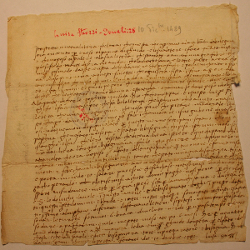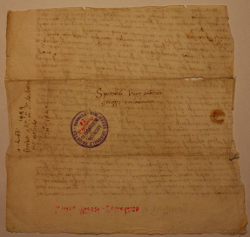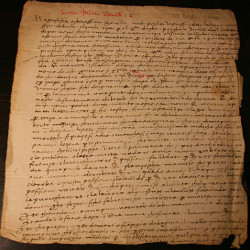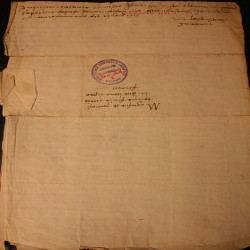TWO LETTERS OF A STROZZI WIDOW (1471-1510):
A DIGITAL CRITICAL EDITION
Edition by Lisa Di Crescenzo
Queen Mary University of London
Letter To Roberto Strozzi in La Badia, 10 December 1489 To Leona Strozzi in Ferrara, 23 July 1510
The Manuscripts
The two manuscript letters offered in the edition belong to the epistolary corpus of the Florentine émigré Luisa Donati Strozzi (1434-1510). An important and largely unknown collection of a woman’s vernacular-authored letters, the texts form part of the vast body of correspondence composed by the descendants of Palla Strozzi throughout their long exile from Florence and dispersal to Padua, Venice and Ferrara. Although an unknowable proportion of the collection from the fifteenth and early sixteenth centuries has been lost, a total of 212 extant letters have been identified to date, and are located in five different repositories across northern and central Italy. The surviving correspondence chronologically spans 1471 to 1510. The two letters selected here belong to the collection of Luisa Strozzi’s letters held in the Archivio Bentivoglio in the Archivio di Stato, Ferrara, where the bulk of her correspondence is preserved.Luisa Donati Strozzi (1434-1510): An Introductory Biography
Luisa Caterina Donati was born in Florence on 10 February 1434 into two magnate lineages: the Velluti on the maternal side and the Donati on the paternal side. Manno Donati’s clan was excluded from most political offices but, like a number of magnates, had many friends among the deposed and exiled power group of 1434. Betrothed to Giovanfrancesco di Palla Strozzi in Bologna in 1448, the marriage was publically celebrated in Verona in 1449: though the Strozzi-Donati parentado forged was a politically impotent alliance. Re-exiled by the Medicean regime for six decades, the protracted persecution of the Strozzi had long-lasting implications for Luisa’s life course. Following her marriage, Luisa migrated from her natal city to join the Strozzi branch in exile, settling permanently in the northeastern towns of Padua and Ferrara where she remained throughout her long widowhood until her death on 31 October 1510. For the most part, Luisa corresponded with her exiled sons, with fewer surviving letters to other male and female relatives, notaries, factotums of the Strozzi estate at Villabona, and members of the ducal families of Ferrara, Modena and Mantua. Once brought together as a corpus the correspondence offers a view from an array of vantage points of a Strozzi woman’s life cycle. Significantly, Luisa’s position in the Strozzi family and lineage over time was neither monolithic or passive nor subordinate. On the contrary, over the wide chronological scope of the correspondence, we encounter Luisa at different ages and in a variety of familial, socioeconomic and cultural situations, navigating the vicissitudes caused by exile, migration, widowhood, and the Italian wars.The Edition
As the surviving letters extended across almost four decades, the selection of the letters offered in this edition has been based on two main criteria. First, given the edition is a short one, it was important that the two letters included were those which carried forward important aspects of Luisa’s life: her implication in the exile and greater doings of the Strozzi men, and the myriad ways in which exile, resettlement and widowhood could both suppress and activate female and family agency. Second, the two letters were chosen for inclusion in the edition because of their thematic variety, and the degree to which they begin to illuminate the range of attitudes, concerns, and activities that were emblematic of the Strozzi widow. Luisa’s letters are modelled on the structural conventions of the mercantile correspondence of the period. The two letters offered in the edition demonstrate their loose tripartite structure: they begin with a salutation, and opening lines that perform an epistolary stock take; the body of the letter addresses topics of pressing concern: familial, financial, political, or otherwise, followed by a concluding signal of closure. Once written, Luisa’s letters were tucked and folded, secured with wax, and the addressee and his or her location added on the verso of the letter. The edition offers a transcription of the two letters included. Each of the manuscript letters is marked up on XML and the TEI P5 guidelines have been followed wherever possible. The model for digital editing implemented combines XML data, largely diplomatic transcript with semi-normalised features, and colour digital images of the manuscripts with a detailed commentary on the language and content of the two letters. Named entities focus on people and places. I had a number of editorial aims. The first of these was to undertake a transcription and mark up of the manuscripts using colour digital images. In both cases, the transcriptions were based on earlier transcriptions taken from the original documents themselves, in situ, at the Archivio di Stato in Ferrara. The second of these aims was to attempt to present the letters as close to the original hand-written letters as possible and to represent the flavour of their oral character. For example, line-endings are preserved, word divisions follow the manuscript as far as possible, and the original spelling and orthographic variations in Luisa’s vernacular are retained. A third editorial aim was to illuminate the dialectical elements in Luisa Strozzi’s epistolary vernacular. Luisa’s letter to her relative Leona Strozzi in 1510, included here in the edition, is of particular interest for the hybrid of Italian dialects observable in her writing. The Florentine Tuscan is, on occasion, overlaid, with Veneto or Ferrarese and the z sound tends to supplement the place of the g and c of Tuscan. This ‘coating of northern dialectal elements’ demonstrates the linguistic variations, perhaps even mutilations, to which women who left their natal cities in Renaissance and early modern Italy could be subjected.1 It is hoped that the two letters offered in this XML-based edition will begin to open up important new lines of inquiry into gender, agency, and women and the phenomena of judicial banishment and forced migration in fifteenth- and sixteenth-century Italy. Moreover, as a woman’s epistolary collection that survives from the Renaissance period, Luisa Strozzi’s letters provide new terrain from which to navigate the epistolary practices and writing technologies of laywomen in the Renaissance and early modern period.A Note on the Transcription
The transcription and translation of Luisa Strozzi’s letters is a work currently in progress. The question of how to read and how to package two of Luisa’s letters, and the consideration of how these relate to the genre of the familiar letter were foremost in the editorial enterprise. The letters remain close to Luisa’s spoken register, and her communications carry considerable emotive force and interpersonal function. As such, in normalizing the transcription and, in particular, the punctuation, I have sought to retain Luisa’s many long and intricate sentences. To this end, I have followed Cesare Guasti’s tendency to use colons and semi colons in his nineteenth-century editing of the correspondence of Alessandra Strozzi. The original spelling has been retained, including errors and irregularities, and epistolary moments of layered dialects. Contractions have been expanded. When the transcription of a word is conjectural, the letter or word has been supplied within a set of square brackets. In addition, where it has not been possible to repair omitted or obscured letters or words in damaged sections of the manuscripts, an ellipsis in square brackets is inserted. Words or letters deleted in the letter by Luisa herself are indicated by an overstrike.Acknowledgements
I am grateful to the Archivio di Stato, Ferrara, for permission to photograph and reproduce the manuscripts from the Strozzi corpus preserved in the Archivio Bentivoglio. I would like to thank Petra Galuscakova and Jean-Paul Rehr for their assistance with this edition. I also thank the European Union’s Erasmus+ Programme, DEMM 2016/17, and Queen Mary University of London.1 Olivia Holmes, Assembling the Lyric Self: Authorship from Troubadour Song to Italian Poetry Book, (University of Minnesota Press: London, 2000), p. 217, n. 12.



